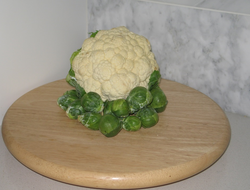Cauliflower: White (and green, and purple and yellow) is NUTRITIOUS!
Published: December 06, 2019
Rumour has it that “white” foods are not nutritious and may even be “bad” for you. Should you take heed of this rumour and shun all white foods?
It has been suggested that white foods such as potatoes, foods processed from white flour (pasta and bread) and sugar, all of which have a relatively high glycemic index, may contribute to weight gain and increased risk for obesity.
Overweight and obesity in turn are thought to increase your risk of related chronic diseases, such as diabetes type 2, hypertension, heart disease and increased blood cholesterol.
However this does not imply that these foods are devoid of nutrients and that all ‘white” foods should be avoided altogether. Take cauliflower as an example.
White in a family of predominantly green
Cauliflower is one of several vegetables known as cruciferous vegetables.
These vegetables for the most part are varying shades of green, for example, several varieties of cabbage, Brussels sprouts, broccoli, collard greens, and kale.
There are exceptions such as purple sprouting broccoli, purple cabbage, purple kale and purple, white and yellow cauliflower. Just to be at home with its relatives, there is also a green variety of cauliflower.
This group of vegetables belongs to the species Brassica oleracea, within the Brasicace family. Turnips which are both a root and leaf crop are also part of the Brassica genus.
Cauliflower heads appear to be similar to broccoli heads, but where the heads of broccoli are made up of flower buds, white inflorescence meristem (white curd) form cauliflower heads.
Nutrients
The white variety of cauliflower is the most commonly available varietal, but despite its “whiteness” cauliflower provides a range of essential...link to the full article to learn more.
References
1.
Whitney, E. & Rady Rolfes, S. (2005). Understanding Nutrition. Belmont, CA: Thomson Wadsworth
2.
Readers Digest: Gardening in Canada

